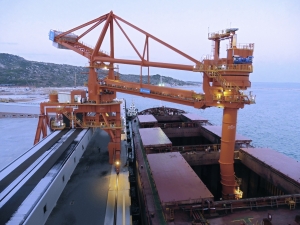


(Posted on 18/04/19)
As part of its plans to expand power supplies in the Guangzhou/Hong Kong/Shenzhen conurbation, the Chinese company New Energy Power Co. Ltd. commissioned thyssenkrupp Industrial Solutions with the construction and delivery of a continuous ship unloader (CSU) in 2015. Since the end of 2018 the ship unloader is keeping a new power plant in the Chinese city of Lufeng supplied with coal. The machine can unload 2,000 tons of coal per hour from ships with deadweight capacities of between 50,000 and 150,000 tons.
The thyssenkrupp ship unloader is characterized by eco-friendly and continuous transportation of material from the hull of the ship up to the pier conveyor. The coal, which is picked up in the horizontal section of the L-shaped bucket elevator, is transferred to the boom belt of the ship unloader via a rotating distributor on the bucket elevator head. From there the coal flows through the center of the machine on an intermediate conveyor which acts as a link to the pier conveyor. Ensuring the stability and reliability of the system was a particular focus of development work due to the in part extreme weather conditions in the region. The whole conveying route from the ship hatch through the unloader up to the pier conveyor is enclosed, meaning that there is only limited dust or material spillage, even in strong winds.
The longitudinal axis of the unloader conveyor can be moved in three dimensions. The lifting and slewing movement of the entire boom and the fact that the bucket elevator can be rotated through 360 degrees ensure that all the coal deposits can be collected from a ship hatch, even those close to the floor and sides of the hull. The operator of the unloader is supported by a computer-aided unloading (CAU) function. In an automated operation the coal is removed layer by layer down to the floor of the hull. An additional mobile device is then only needed at a later stage to collect residues. The mobile device is lifted from the pier into the hatch from an attachment point on the base of the bucket elevator and then moved to other hatches on completion of its work. The ship unloader can be operated from the cab on the boom head or remotely from the pier or ship’s hatch.
Use of continuous systems for bulk material unloading is on the increase, especially in the medium- to high-output ranges. These unloader types permit the effective, dust-free and low-noise unloading of coal, ores, phosphates, sulfur, fertilizers and other bulk materials from ships. thyssenkrupp developed the continuous ship unloader back in the 80s and has since supplied more than 60 systems to customers around the world.
Leading vessel performance platform Smart Ship Hub says the industry should expect a breakthrough year... Read more
The Nordic countries are taking an important step towards decarbonising maritime transport with the... Read more
Germany’s Steelpaint has appointed ADD Marine as its representative for Greece and Cyprus, strengthening... Read more
Rio Tinto’s first Pilbara-made iron ore rail car has rolled off the production line in Karratha... Read more
Precision meets progress at Phu My Port, Vietnam. The LPS 550 has been deployed to handle bulk commodities... Read more
bound4blue, a global leader in wind propulsion systems, has expanded its industrial footprint in Asia... Read more
As the industry explores multiple decarbonisation pathways, methanol is gaining attention as a practical... Read more
Technology group Wärtsilä will supply an integrated hybrid propulsion system for a bulk carrier... Read more
Superior Industries, Inc., a US-based manufacturer and global supplier of bulk material processing and... Read more
ESL Shipping has taken a significant step forward in digitalisation by deploying a new multichannel... Read more